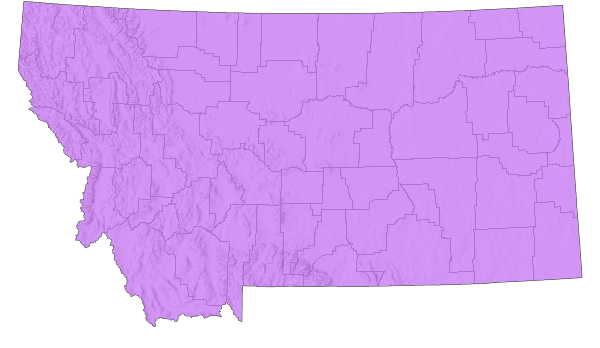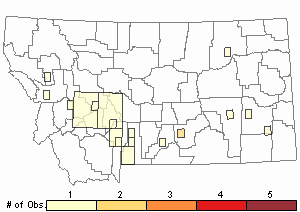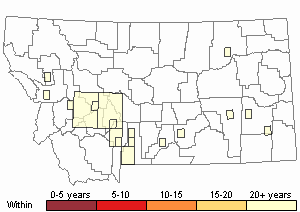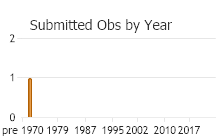View in other NatureServe Network Field Guides
NatureServe
Montana
Utah
Wyoming
Idaho
Wisconsin
British Columbia
South Carolina
Yukon
California
New York
Occidental Grasshopper - Melanoplus occidentalis
General Description
The following is taken from Hebard (1928), Brooks (1958), Vickery and Kevan (1985), Pfadt (2002), Capinera and Sechrist (1982), Capinera et al. (2004), and Scott (2010). This small to medium sized species is perhaps one of the most colorful of the Melanoplus genera, especially with its bright orange inner face of the hind femur and light blue tibia. The outer face of the hind femur is tan and crossed transversely with three dark bars. The middle bar is usually chevron shaped.
Phenology
Hatching and nymphs occur from mid-May to mid-June. Adults present from late June through October.
Diagnostic Characteristics
Taken from Hebard (1928), Brooks (1958), Vickery and Kevan (1985), Pfadt (2002), Capinera et al. (2004), Capinera and Sechrist (1982), and Scott (2010). The body length to end of forewings is 19 to 21 mm for males, and females is 22 to 24 mm. Wings (tegmina) extend to or slightly beyond the abdominal tip and have a row of alternating light and dark square spots centrally. The cercus of the male genitalia is diagnostic: it is unusually large and triangular, appearing ear-like or fan shaped.
Can be confused with the
Nevada Sage Grasshopper (
M. rugglesi), to which it is related. The two species can be separated by comparing the shape of the males genital cerci, which does not taper to a point at the tip in
M. rugglesi (Capinera et al. 2004).
Species Range
Montana Range
Range Descriptions

 Native
Native
Range Comments
Occurs throughout the Great Plains, ranging from the western Canadian provinces to western Minnesota, and southward to Arizona, New Mexico, and west Texas. In Montana, it has been recorded in 42 counties, but probably occurs more extensively throughout the state’s grassland communities (Hebard 1928, Brooks 1958, Vickery and Kevan 1985, Pfadt 2002, Capinera et al. 2004, Capinera and Sechrist 1982, and Scott 2010).
Observations in Montana Natural Heritage Program Database
Number of Observations: 22
(Click on the following maps and charts to see full sized version)
Map Help and Descriptions
Relative Density

Recency


 (Observations spanning multiple months or years are excluded from time charts)
(Observations spanning multiple months or years are excluded from time charts)
Habitat
The Occidental Grasshopper inhabits nearly all the grassland/prairie types in the Great Plains, with highest densities observed in mixed grass prairie. This species also occurs in open grassy areas at mountain elevations to >12,000 feet above timberline (Vickery and Kevan 1985, Capinera et al. 2004, Capinera and Sechrist 1982, Pfadt 2002, and Scott 2010).
Food Habits
The following comes from Pfadt (2002), Capinera et al. (2004), and Capinera and Sechrist (1982). A polyphagous grasshopper, favoring the leaves of forbs but also consumes substantial amounts of grasses, moss, roots, seeds and dying or dead arthropods. In mixed-grass prairie studies, food contents consisted of 70 to 90 percent forbs, 8 to 15 percent grasses and 1 to 10 percent arthropod parts. Favored plants include
scarlet globemallow (
Sphaeralcea coccinea), wild buckwheat, milkvetch,
blue grama (
Bouteloua gracilis),
needle-and-thread (
Stipa comata), and
western wheatgrass (
Elymus smithii).
Reproductive Characteristics
The following is taken from Pfadt (2002), Capinera et al. (2004), and Vickery and Kevan (1985). This species overwinters in the egg stage. Nymphs pass through 5 instars before becoming adults in 40 to 45 days. Females begin laying eggs within about 2 weeks after fledging to the adult stage. Eggs are laid in bare spots. She deposits 8 to 10 eggs per pod arranged in two columns. Adults remain in the same habitat in which the eggs hatch and nymphs develop.
Management
The Occidental Grasshopper rarely reaches outbreak pest population densities but can contribute significantly to total grasshopper outbreak densities in concert with other pest species. This species is a common member among prairie grasshopper assemblages and can be a crop pest (Pfadt 2002, and Schell et al. 2005).
References
- Literature Cited AboveLegend:
 View Online Publication
View Online Publication Brooks, A.R. 1958. Acridoidea of Southern Alberta, Saskatchewan, and Manitoba (Orthoptera). The Canadian Entomologist (Supplement 9) 90:5-92.
Brooks, A.R. 1958. Acridoidea of Southern Alberta, Saskatchewan, and Manitoba (Orthoptera). The Canadian Entomologist (Supplement 9) 90:5-92. Capinera, J.L. and T.S. Sechrist. 1982. Grasshoppers of Colorado: Identification, Biology, and Management. Fort Collins, CO: Colorado State University Experiment Station, Bulletin 584S. 161 p.
Capinera, J.L. and T.S. Sechrist. 1982. Grasshoppers of Colorado: Identification, Biology, and Management. Fort Collins, CO: Colorado State University Experiment Station, Bulletin 584S. 161 p. Capinera, J.L., R.D. Scott, and T.J. Walker. 2004. Field Guide to Grasshoppers, Katydids, and Crickets of the United States. Ithaca, NY. Cornell University Press.
Capinera, J.L., R.D. Scott, and T.J. Walker. 2004. Field Guide to Grasshoppers, Katydids, and Crickets of the United States. Ithaca, NY. Cornell University Press. Hebard, M. 1928. The Orthoptera of Montana. Proceedings of the Academy of Natural Sciences of Philadelphia, Vol. 80:211-306.
Hebard, M. 1928. The Orthoptera of Montana. Proceedings of the Academy of Natural Sciences of Philadelphia, Vol. 80:211-306. Pfadt, R.E. 2002. Field Guide to Common Western Grasshoppers, 3rd edition. Laramie, WY: Wyoming Agricultural Experiment Station, Bulletin 912, modified by S. Schell and S. Schell for electronic publication. Accessed 19 February 2020. http://www.uwyo.edu/entomology/grasshoppers/field-guide/index.html#fieldguidetoc
Pfadt, R.E. 2002. Field Guide to Common Western Grasshoppers, 3rd edition. Laramie, WY: Wyoming Agricultural Experiment Station, Bulletin 912, modified by S. Schell and S. Schell for electronic publication. Accessed 19 February 2020. http://www.uwyo.edu/entomology/grasshoppers/field-guide/index.html#fieldguidetoc Scott, R.D. 2010. Montana Grasshoppers, Katydids, and Crickets A Pictorial Field Guide to the Orthoptera. MagpieMTGraphics, Billings, MT.
Scott, R.D. 2010. Montana Grasshoppers, Katydids, and Crickets A Pictorial Field Guide to the Orthoptera. MagpieMTGraphics, Billings, MT. Vickery, V. R. and D. K. M. Kevan. 1985. The grasshopper, crickets, and related insects of Canada and adjacent regions. Biosystematics Research Institute, Ottawa, Ontario. Publication Number 1777. 918 pp.
Vickery, V. R. and D. K. M. Kevan. 1985. The grasshopper, crickets, and related insects of Canada and adjacent regions. Biosystematics Research Institute, Ottawa, Ontario. Publication Number 1777. 918 pp.
- Additional ReferencesLegend:
 View Online Publication
View Online Publication
Do you know of a citation we're missing? Anderson, N.L. 1962. Grasshopper-vegetation relationships on Montana grasslands. Ph.D Dissertation. Bozeman, Montana: Montana State University. 73 p.
Anderson, N.L. 1962. Grasshopper-vegetation relationships on Montana grasslands. Ph.D Dissertation. Bozeman, Montana: Montana State University. 73 p. Mussgnug, G.L. 1972. The structure and performance of an adult population of Aulocara elliotti (Thomas) (Orthoptera, Acrididae) near Billings, Montana. M.Sc. Thesis. Bozeman, MT: Montana State University. 97 p.
Mussgnug, G.L. 1972. The structure and performance of an adult population of Aulocara elliotti (Thomas) (Orthoptera, Acrididae) near Billings, Montana. M.Sc. Thesis. Bozeman, MT: Montana State University. 97 p. Skinner, K.F. 1995. Plant and grasshopper community composition: indicators & interactions across three spatial scales. M.Sc. Thesis. Bozeman, MT: Montana State University. 144 p.
Skinner, K.F. 1995. Plant and grasshopper community composition: indicators & interactions across three spatial scales. M.Sc. Thesis. Bozeman, MT: Montana State University. 144 p.
- Web Search Engines for Articles on "Occidental Grasshopper"
- Additional Sources of Information Related to "Insects"





